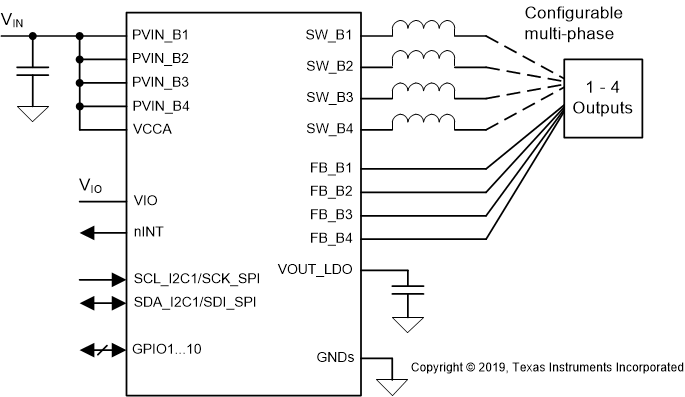JAJSO71 March 2022 LP8764-Q1
PRODUCTION DATA
- 1 特長
- 2 アプリケーション
- 3 説明
- 4 Revision History
- 5 Pin Configuration and Functions
-
6 Specifications
- 6.1 Absolute Maximum Ratings
- 6.2 ESD Ratings
- 6.3 Recommended Operating Conditions
- 6.4 Thermal Information
- 6.5 Internal Low Drop-Out Regulators (LDOVINT)
- 6.6 BUCK1, BUCK2, BUCK3, and BUCK4 Regulators
- 6.7 Reference Generator (REFOUT)
- 6.8 Monitoring Functions
- 6.9 Clocks, Oscillators, and DPLL
- 6.10 Thermal Monitoring and Shutdown
- 6.11 System Control Thresholds
- 6.12 Current Consumption
- 6.13 Digital Input Signal Parameters
- 6.14 Digital Output Signal Parameters
- 6.15 I/O Pullup and Pulldown Resistance
- 6.16 I2C Interface
- 6.17 Serial Peripheral Interface (SPI)
- 7 Typical Characteristics
-
8 Detailed Description
- 8.1 Overview
- 8.2 Functional Block Diagram
- 8.3 Input Voltage Monitor
- 8.4
Device State Machine
- 8.4.1 Fixed Device Power FSM
- 8.4.2
Pre-Configurable Mission States
- 8.4.2.1
PFSM Commands
- 8.4.2.1.1 REG_WRITE_IMM Command
- 8.4.2.1.2 REG_WRITE_MASK_IMM Command
- 8.4.2.1.3 REG_WRITE_MASK_PAGE0_IMM Command
- 8.4.2.1.4 REG_WRITE_BIT_PAGE0_IMM Command
- 8.4.2.1.5 REG_WRITE_WIN_PAGE0_IMM Command
- 8.4.2.1.6 REG_WRITE_VOUT_IMM Command
- 8.4.2.1.7 REG_WRITE_VCTRL_IMM Command
- 8.4.2.1.8 REG_WRITE_MASK_SREG Command
- 8.4.2.1.9 SREG_READ_REG Command
- 8.4.2.1.10 SREG_WRITE_IMM Command
- 8.4.2.1.11 WAIT Command
- 8.4.2.1.12 DELAY_IMM Command
- 8.4.2.1.13 DELAY_SREG Command
- 8.4.2.1.14 TRIG_SET Command
- 8.4.2.1.15 TRIG_MASK Command
- 8.4.2.1.16 END Command
- 8.4.2.2 Configuration Memory Organization and Sequence Execution
- 8.4.2.3 Mission State Configuration
- 8.4.2.4 Pre-Configured Hardware Transitions
- 8.4.2.1
PFSM Commands
- 8.4.3 Error Handling Operations
- 8.4.4 Device Start-up Timing
- 8.4.5 Power Sequences
- 8.4.6 First Supply Detection
- 8.5 Power Resources
- 8.6 Residual Voltage Checking
- 8.7 Output Voltage Monitor and PGOOD Generation
- 8.8 General-Purpose I/Os (GPIO Pins)
- 8.9 Thermal Monitoring
- 8.10 Interrupts
- 8.11 Control Interfaces
- 8.12 Multi-PMIC Synchronization
- 8.13 NVM Configurable Registers
- 8.14
Watchdog (WD)
- 8.14.1 Watchdog Fail Counter and Status
- 8.14.2 Watchdog Start-Up and Configuration
- 8.14.3 MCU to Watchdog Synchronization
- 8.14.4 Watchdog Disable Function
- 8.14.5 Watchdog Sequence
- 8.14.6 Watchdog Trigger Mode
- 8.14.7 WatchDog Flow Chart and Timing Diagrams in Trigger Mode
- 121
- 8.14.8 Watchdog Question-Answer Mode
- 8.15 Error Signal Monitor (ESM)
- 8.16 Register Map
- 9 Application and Implementation
- 10Power Supply Recommendations
- 11Layout
- 12Device and Documentation Support
- 13Mechanical, Packaging, and Orderable Information
1 特長
- 下記内容で AEC-Q100 認定済み:
- 入力電圧:2.8 V~5.5V
- デバイス温度グレード 1:–40℃~+125℃の動作時周囲温度範囲
- デバイス HBM ESD 分類レベル 2
- デバイス CDM ESD 分類レベル C4B
- 機能安全準拠
- 機能安全アプリケーション向けに開発
- ASIL-D までの ISO 26262 システムの設計に役立つ資料を提供
- SIL-3 までの IEC 61508 システムの設計に役立つ資料を提供
- ASIL-D までの決定論的能力
- ASIL-D までのハードウェア安全度
- 電圧および過電流のウィンドウ・モニタ
- トリガ / Q&A モードを選択可能なウォッチドッグ
- レベルまたは PWM エラー信号モニタ (ESM)
- 温度監視と高温警告およびサーマル・シャットダウン
- 構成レジスタと不揮発性メモリ (NVM) のビット整合性 (CRC) エラー検出
- 4 つの高効率降圧 DC/DC コンバータ:
- 出力電圧:0.3V~3.34V (多相出力で 0.3V~1.9V)
- 最大出力電流:1 相あたり 5A、4 相構成で最大 20A
- 出力電圧のスルーレートをプログラム可能:0.5mV/µs~33mV/µs
- スイッチング周波数:2.2MHz または 4.4MHz
- 構成可能な 10 個の汎用 I/O (GPIO)
- マルチ PMIC 同期用 SPMI インターフェイス
- 入力過電圧保護 (OVP) および低電圧誤動作防止 (UVLO)
 概略回路図
概略回路図